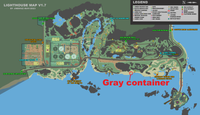Explore web search results related to this domain and discover relevant information.
Search for cargo airport station information or cargo facilities including addresses, hours of operation and pick up and drop off times. Learn about products, services, aircraft specifications and flight and truck schedules. Submit claims, trace request and more.
Explore the latest flight and truck connections to keep your cargo moving. Learn more Next · 1 · 2 · 3 · My Bookings · Track my shipment · My air waybill · Station Information · GEN · EXP · QuickPak · UAPremium · TrustUA · LifeGuard · TempControl ·Book, track and manage freight shipments. Explore UnitedCargo.com. Register for a United Cargo account, online booking access or United Cargo Billing access. Search for cargo airport station information or cargo facilities including addresses, hours of operation and pick up and drop off times.We’re thrilled to share an exciting milestone for one of our own. Jan Krems, President of United Cargo, has officially been inducted into the TIACA Hall of Fame—one of the highest honors in the global air cargo world!Read moreAs one of United Cargo’s largest and most critical hubs, George Bush Intercontinental Airport (IAH) serves as a dynamic connector between North America, Latin America, and the global market.
This command displays information about a package. It fetches data from the package’s Cargo.toml file and presents it in a human-readable format.
If Cargo has been installed with rustup, and the first argument to cargo begins with +, it will be interpreted as a rustup toolchain name (such as +stable or +nightly). See the rustup documentation for more information about how toolchain overrides work.Overrides a Cargo configuration value. The argument should be in TOML syntax of KEY=VALUE, or provided as a path to an extra configuration file. This flag may be specified multiple times. See the command-line overrides section for more information.This affects things like where cargo looks by default for the project manifest (Cargo.toml), as well as the directories searched for discovering .cargo/config.toml, for example. This option must appear before the command name, for example cargo -C path/to/my-project build. This option is only available on the nightly channel and requires the -Z unstable-options flag to enable (see #10098). ... Prints help information.This command displays information about a package. It fetches data from the package’s Cargo.toml file and presents it in a human-readable format.
To book Air Charter, Sea-Air, Maersk Air Cargo or special services – or simply talk to us about your air freight needs – please get in touch. ... Head to our contact form to start an enquiry. ... Pick enquiry type. For new customers, select ‘booking’. ... Fill in your contact information ...
To book Air Charter, Sea-Air, Maersk Air Cargo or special services – or simply talk to us about your air freight needs – please get in touch. ... Head to our contact form to start an enquiry. ... Pick enquiry type. For new customers, select ‘booking’. ... Fill in your contact information and submit.Unlock flexible logistics for technology cargo with integrated solutions that ensure secure and speedy delivery. Embrace seamless pharmaceutical logistics with integrated cold chain solutions that safeguard product integrity. Keep your commodities fresh or frozen with integrated cold chain logistics that ensure visibility from source to market. Access your local office for detailed shipping information and local support.Yes, you can get the real-time status of your shipments from our air cargo tracking page. ... Reach your full potential by letting us simplify and connect your supply chain from end to end. Strengthen your business with strategically located warehouses from Maersk. ... Integrate customs into your end-to-end supply chain logistics. ... Be it shipping small boxes or pallets, our LCL services ensure on-time shipment and delivery. ... If you need further information about our services, please fill out the form below with your details and request, and we will get in touch with you as soon as possible.Book Maersk Air Freight Services for fast, reliable cargo delivery worldwide. Get instant prices, real-time tracking, and secure global service.

Bridges Air Cargo plans a November start of service for the world’s first E190F after completing the registration and approval...
Etihad Cargo reported $551 million in revenue for the first half of the year, an increase of 8.7% year over...Airfreight technology provider CargoAi is using advanced AI software to automate quoting, tracking, emailing and payments.As 2025 progresses, the Asia-Europe corridor has emerged as the standout performer in global air cargo.Do not sell my personal information.

Here's a guide video that shows you everything you need to know about the Cargo Ship. It includes information about how to get onto the ship, how to evacuate the ship, what kind of loot is on the ship and much, much more.
The Cargo ship, also known as the "CCSC Lazarus" is mobile Monument that only spawns periodically.When it spawns, it circles the map a few times, then leaves the area. There is no Radiation on the Cargo Ship while it is circling the map, but when it leaves, the Radiation poisoning quickly demolishes your health.The Cargo Ship is inhabited by Scientists and often other hostile players, so its not recommended for starting players to attempt to board the ship.
Air Cargo News is the leading provider of news, information, interviews, analyses and reports to the global airfreight industry.
Interested in the latest developments in air cargo? Air Cargo News is the leading provider of news and analysis on the airfreight industry. Learn moreRead the latest issue of Air Cargo News and view our online archive.Hong Kong Air Cargo Terminals Ltd (Hactl) has secured SolitAir as its newest customer, supporting the Dubai-based carrier’s expansion into Hong Kong with Boeing 737-800BCF operations.All-cargo operator Northern Air Cargo will begin a new Seattle-Anchorage freighter service in early October, strengthening supply chain connections to rural Alaska

Copyright © 2025 ILS Cargo. All rights reserved. ... By using this website you agree to the use of cookies for analytics and personalized content. You can find more information about the cookies we use in our privacy policy page.
ILS Cargo is an international logistics company providing freight forwarding, time critical and customs clearance solutions all over the worldILS Cargo has been providing logistics solutions to many kinds of industries. We know that every industry has its own particular requirements, which are taken into consideration in each of our special solutions project. Find out more about these solutions in our cases section.ILS Cargo makes your import / export process easier.We deliver your cargo where and when you need it.

For full functionality of this site it is necessary to enable JavaScript

The IATA Cargo Agency Program enables any company involved in international air freight to simplify their interaction with airlines and smooth the way for growth. Two services, designed to meet the needs of your business, streamline your financial operations. ... We use cookies to give you the best experience on our website. We also use cookies for advertising purposes. Please see our privacy policy and cookies policy for complete information...
To support air cargo, IATA is committed to deliver enhanced value for the industry by driving a safe, secure, profitable & sustainable supply chain.Airlines transport over 62 million cargo tonnes of goods a year, representing more than 33% of global trade by value but less than 1% of world trade by volume. That is equivalent to $8.3 trillion worth of goods annually, or $22.7 billion worth of goods every day.Find out more interesting air cargo facts (pdf).Safety and Security, including the lithium battery challenge where governments must address the threat from undeclared dangerous goods in cargo and mail.

Discover new logistics terms with the DHL logistics dictionary. Learn what does Cargo mean.
Cargo, also known as freight, refers to goods or produce being transported from one place to another by water, air or land. Originally, the term "cargo" referred to goods being loaded onboard a vessel.These days, however, cargo is used for all types of goods, including those carried by rail, van, truck, or intermodal container.Though cargo means all goods onboard a transport vehicle, it does not include items such as personnel bags, goods in the storage, equipment or products to support the transport carried onboard.Cargo transport is mainly for commercial purpose for which an air waybill, bill of lading or other receipt is issued by the carrier.

The term Cargo refers collectively to all tradeable material carried by a ship. Each version of Pirates! features several types of Cargo that can be bought, sold or looted, then placed in a ship's hold and carried across the Caribbean. Some Cargo serves only for trade, other Cargo used by your ...
The term Cargo refers collectively to all tradeable material carried by a ship. Each version of Pirates! features several types of Cargo that can be bought, sold or looted, then placed in a ship's hold and carried across the Caribbean. Some Cargo serves only for trade, other Cargo used by your crew in or out of battle.Each ship can carry a finite, pre-defined amount of Cargo, based on its Ship Type. Cannons and Food are both considered Cargo, and behave in much the same way as all other types of cargo, despite having more importance than as mere trade goods.Crewmen, though carried on a ship, are not Cargo and do not take up Cargo space.The Caribbean Economy and its fluctuations make trade in Cargo possible, though it is not nearly as profitable as looting cargo off enemy Prizes.
Cargo Facts has been the newsletter of record of the air cargo and freighter aircraft industries for more than 40 years. Cargo Facts, published by Royal Media, provides its readers with timely, actionable news and industry intelligence. The deep value in Cargo Facts centers on its detailed ...
Cargo Facts has been the newsletter of record of the air cargo and freighter aircraft industries for more than 40 years. Cargo Facts, published by Royal Media, provides its readers with timely, actionable news and industry intelligence. The deep value in Cargo Facts centers on its detailed coverage of the market and exploration of every nuance of air cargo and freighter […]Cargo Facts offers a Premium subscription service, which includes a digital monthly newsletter, a weekly email Update, exclusive event discounts, and more. The Cargo Facts Premium subscription provides subscribers with unparalleled coverage of the market.The deep value in Cargo Facts centers on its detailed coverage of the market and exploration of every nuance of air cargo and freighter aircraft.Cargo Facts produces the following leading industry events: Cargo Facts EMEA, Cargo Facts Asia, Cargo Facts Symposium, and the newest edition Cargo Facts LATAM.
For any kind of assistance concerning the transport of your cargo please contact your nearest Hapag-Lloyd office. ... In this brochure you will find information in order to protect your cargo as best as possible.
Hapag-Lloyd offers suitable container types for any kind of cargo.We also offer innovative transport solutions for any kind of special cargo.Suitable for any general cargo. All containers are equipped with various lashing devices on longitudinal rails and corner posts. The High Cube container is specially designed for voluminous cargo.Special containers are available for heavy loads and oversize cargo as well as project cargo.

A pirate's ship vessel can hold various plunder taken from the ships they sink. The cargo varies widely, but the larger and more dangerous the vessel - usually the more valuable the cargo found. Boarding flagships can result in more and better plunder. Also, captains having the Treasure Sense ...
A pirate's ship vessel can hold various plunder taken from the ships they sink. The cargo varies widely, but the larger and more dangerous the vessel - usually the more valuable the cargo found. Boarding flagships can result in more and better plunder. Also, captains having the Treasure Sense ability of the Sailing skill can locate the best booty to take.Once a ship's hold is full, any NEW plunder will replace the old IF the new items found are more valuable. So, a dedicated pirate could eventually fill their ship with a lot of valuable cargo. But, remember - if you're sunk, it's all lost.During a prolonged voyage, a pirate may not remember all they have plundered. At any time, even when not aboard your own ship - you can check the manifest. Simply click on the Cargo Crate icon in the upper-left and a list of total number of Crates, Chests, and Materials and Loot items will appear by type.Game Note: The percentages of the higher quality cargo goes up with each level of Treasure Sense skill or Treasure Sense Skill Boost, with a Navigation Tool.

Language update adds info subcommand to Cargo that provides detailed information about packages in the Cargo registry.
Rust 1.82, the newest version of the popular memory-safe programming language, fulfills a longstanding request for displaying information in the Cargo package manager registry.For Cargo, Rust adds a cargo info subcommand to show information about a package in the registry. This feature has been requested for nearly 10 years.Third-party extensions like this have been written over the years; this implementation was developed as cargo-information before merging into Cargo itself.Paul Krill is editor at large at InfoWorld.

Missing Cargo is a Quest in Escape from Tarkov. Must be level 30 to start this quest. Locate the crashed helicopter on Lighthouse Find the informant's intelligence folder Hand over the folder to Skier +14,000 EXP Skier Rep +0.03 68,000 Roubles 71,400 Roubles with Intelligence Center Level 1 ...
Missing Cargo is a Quest in Escape from Tarkov. Must be level 30 to start this quest. Locate the crashed helicopter on Lighthouse Find the informant's intelligence folder Hand over the folder to Skier +14,000 EXP Skier Rep +0.03 68,000 Roubles 71,400 Roubles with Intelligence Center Level 1 78,200 Roubles with Intelligence Center Level 2 Unlocks purchase of AR-15 Magpul MOE Carbine stock (Black) at Skier LL3 Unlocks purchase of AK Zenit RK-3 pistol grip at Skier LL3 Unlocks purchase of...And the damn chopper was there too? Looks like the rumors were true. I knew it couldn't have gone far. Otherwise, there would've been a big uproar! The USECs had no reason to spread the info through, they were probably waiting for orders from the command, but, well, you know what happened.

Abandoned Cargo is a Quest in Escape from Tarkov. ... Good afternoon, young man. I have received information about a recent suspicious shipment of TerraGroup cargo. According to the description, it could contain valuable records and even medical samples. Every such shipment should have been ...
Abandoned Cargo is a Quest in Escape from Tarkov. ... Good afternoon, young man. I have received information about a recent suspicious shipment of TerraGroup cargo. According to the description, it could contain valuable records and even medical samples. Every such shipment should have been prioritized for extraction, yet for some reason this shipment was left near the customs terminal.Abandoned Cargo is a Quest in Escape from Tarkov. Locate and mark the first special TerraGroup cargo with an MS2000 Marker on Customs Locate and mark the second special TerraGroup cargo with an MS2000 Marker on Customs Locate and mark the third special TerraGroup cargo with an MS2000 Marker on Customs Locate and mark the fourth special TerraGroup cargo with an MS2000 Marker on Customs Locate and mark the fifth special TerraGroup cargo with an MS2000 Marker on Customs Locate and mark the...I have to know what's inside the cargo, and to do that, I need the exact location of the shipments. Will you be able to assist with this?In this quest you have to mark 7 cargo pallets on Customs with MS2000 Markers.

In starship classification, freighters, cargo ships, cargo carriers, or cargo vessels were starship types designed to carry cargo, in much the same way transports carried passengers. A bulk freighter was a ship that carried bulk dry goods, comparable to how a tanker carried bulk liquid or gas goods.
(covers information from several alternate timelines) A Talarian freighter · In starship classification, freighters, cargo ships, cargo carriers, or cargo vessels were starship types designed to carry cargo, in much the same way transports carried passengers.Also during the 23rd century, the Federation was known to operate several automated designs, including robot ore freighters and grain ships. These vessels were essentially flying cargo holds that possessed no life support systems.The Star Trek: The Next Generation Technical Manual and the Star Trek Encyclopedia used the less common description "cargo carrier" for this class of starships.The most noticeable feature of freighters were their large cargo bays.
FreightWaves is the most trusted provider of global supply chain market intelligence. Our high-frequency price, demand, and capacity data and analysis allow our customers to benchmark, analyze, monitor and forecast the global physical economy.
Startup cargo airline One Air continues to expand its fleet, airport hubs and service offerings.


Um, let's retire for a couple of minutes. So, the TerraGroup cargo that you found in a secret wall in the Azure Coast sanatorium does not fully comply with the manifests at our disposal. We guess where the cargo was delivered from the sanatorium, but the information is completely classified for now.
Cargo X - Part 4 is a Quest in Escape from Tarkov. Locate and mark the TerraGroup cargo with an MS2000 Marker on Lighthouse Survive and extract from the location +8,600 EXP Peacekeeper Rep +0.02 800 Dollars 840 Dollars with Intelligence center Level 1 920 Dollars with Intelligence center Level 2 Unlocks purchase of Ops-Core FAST MT Super High Cut helmet (Urban Tan) at Peacekeeper LL4 The wanted cargo is a wooden crate that is located next to a gray shipping container on the western shore of...So you found the cargo on the shore, exactly in the place where the TerraGroup transports moored? Okay, so they were shipped straight from the bay... Thank you for your work, mercenary.The wanted cargo is a wooden crate that is located next to a gray shipping container on the western shore of Lighthouse.





